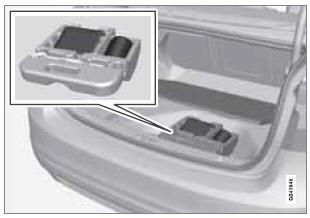Location


The vehicle is equipped with a tire sealing system that enables you to temporarily seal a hole in the tread surface and re-inflate a flat tire, or to adjust a tire’s inflation pressure.
The system consists of an air compressor, a container for the sealing compound, wiring to connect the system to the vehicle’s electrical system via one of the 12-volt sockets, and a hose used to connect the system to the tire’s inflation valve.
The 12-volt sockets are located in the front tunnel console and on the rear side of the center console in the rear seat, see page 201.
Accessing the tire sealing system
The tire sealing system is stowed under the floor of the trunk. To access it:
1. Lift the floor hatch in the cargo area.
2. Lift out the tire sealing system.
![]() NOTE
NOTE
- The tire sealing system is only intended to seal holes on the tire’s tread area, not the sidewall.
- Tires with large holes or tears cannot be repaired with the tire sealing system.
- After use, stow the tire sealing system properly to help prevent rattling.
![]() WARNING
WARNING
- After using the tire sealing system, the vehicle should not be driven farther than approximately 120 miles (200 km).
- Have the tire inspected by a trained and qualified Volvo service technician as soon as possible to determine if it can be permanently repaired or must be replaced.
- The vehicle should not be driven faster than 50 mph (80 km/h) while using a tire that has been temporarily repaired with the tire sealing system.
- After using the tire sealing system, drive carefully and avoid abrupt steering maneuvers and sudden stops.
See also:
Turn signals
When turning
Move the lever as far up or down as possible
(to position 2) to start the turn signals. The turn
signals will be cancelled automatically by the
movement of the steering wheel, or the ...
Limitations
Distance Alert uses the same radar sensor
used by Adaptive Cruise Control and the Collision
Warning system. See page 159 for more
information on the radar sensor’s limitations.
NOTE
Strong sun ...
Main view
Example of RADIO mode's main view
1 Modes (e.g., RADIO, MEDIA etc.), see the
following table.
2 Source menu, e.g., (FM1, DISC, etc.).
Press and hold EXIT on the steering wheel
keypad to displ ...
